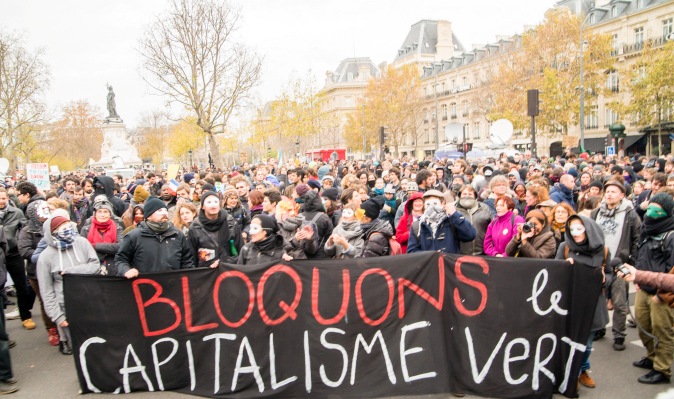The best thing about it is that it may find a way to measure national actions and add them up in an international system, but there is a long way to go before these rules are worked out

- A climate protest that took place in Paris (Image by Duc)
Environment ministers and bureaucrats from 196 governments are struggling in Paris with the draft of an agreement that shows little sign of compromise despite four years of work.
The draft is cleaner and clearly maps out the points of difference and agreement. But it also makes clear that ministers will have to come up with innovative ideas to build new bridges between national positions that will address the climate challenge at the same time.
The current draft requires majority of actions to come from developed countries and emerging economies on controlling greenhouse gas emissions.
Contents and contentions
The core contentions lie in the differentiation between developed and developing countries on undertaking actions on emissions control, the mechanisms of generating and meeting the committed funding targets from 2020 and assessments of commitments made.
On the issue of differentiation, the current draft suggests a shift towards graduation based differentiation. If this goes through, the current binary differentiation between developed and developing countries under the UN Framework Convention on Climate Change will be a thing of the past.
Much of this will depend on whether countries agree to tighten the global average temperature rise ceiling to 1.5 degrees Celsius from two. If it does, emerging economies will have to take substantial mitigation actions in a post 2020 world.
Finance is the other area where the ministers have to thrash out differences, and may well have to refer back to their capitals before the issue is resolved. The current draft only points towards a wide array of options—which automatically reflects divergence of opinion. There are clear indications that emerging economies will be asked to contribute to the financial mechanism of the convention, though they still stout in their opposition to this idea.
In the draft, finance is seen more as means of implementation. The obligation of developed countries to provide finance has been changed to commitment or contribution. There are hints about bracketing the $100 billion per year target from 2020 onwards. Poor nations will fight this, but their success is far from assured. “Why do you think a country with 1.2% growth rate should pay a country with 8%,” a French journalist asked Prakash Javadekar, India’s Environment Minister. Javadekar’s response about historical responsibility did not seem to impress her.
The third most important issue in the draft is that of transparency, compliance and assessments of contributions. This is one point where the entire G77 and China bloc is totally united. The 135 countries want to include rich country support on finance and technology to be part of this section. Developed countries are equally determined to make that bit as vague as possible.
In order to do that, the US and the EU have proposed that stringency of assessment between developed and emerging economies be comparable. This is being vehemently opposed by the BASIC and LMDC groups.
What it means for India
India has been the centre of attraction for its position on many of the issues, and is facing the wrath of developed and least developed countries alike. But within the negotiating rooms, India has not been as vocal as in the past – an indication that it may be ready to relookmany of its stated positions, though perhaps not in Paris.
The issue of graduation and differentiation within developing countries may be agreed by playing around with words—but it will be done at the cost of some assurance on the assessment of contributions and keeping the nature of contributions voluntary.
India is open to review of contributions in future as part of global stocktaking, but wants this to cover the full range of issues – both mitigation actions and support for undertaking actions on mitigations and resilience building. In the first week of the Paris summit, there was apprehension among Indian negotiators that it may not be supported by current G77 chair South Africa on this point. But now there are indications of closer cooperation between the two delegations.
India has been announcing ambitious climate action plans and voluntary emissions, but many developed countries do not consider them adequate.
The Paris agreement will probably be ambivalent about the 1.5 degree goal, with compromises in the areas of finance. It may also make clear that LDCs and most vulnerable countries will have first right on all climate finances.
The good thing about the Paris agreement is that it will pave the way for enhanced actions at national levels. Governments are now gearing up to put in adequate safeguards for future assessments of such actions. From the 2016 climate summit, attention will be on implementing the Paris accord. The Kyoto Protocol was signed in 1997, but it took another eight years before the rules were worked out and it became operational.
